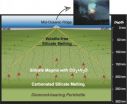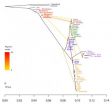(Press-News.org) A landmark discovery about how insulin docks on cells could help in the development of improved types of insulin for treating both type 1 and type 2 diabetes.
For the first time, researchers have captured the intricate way in which insulin uses the insulin receptor to bind to the surface of cells. This binding is necessary for the cells to take up sugar from the blood as energy.
The research team was led by the Walter and Eliza Hall Institute and used the Australian Synchrotron in Melbourne, Australia. The study was published today in the journal Nature.
For more than 20 years scientists have been trying to solve the mystery of how insulin binds to the insulin receptor. A research team led by Associate Professor Mike Lawrence, Professor Colin Ward and Dr John Menting have now found the answer.
Associate Professor Lawrence from the institute's Structural Biology division said the team was excited to reveal for the first time a three-dimensional view of insulin bound to its receptor. "Understanding how insulin interacts with the insulin receptor is fundamental to the development of novel insulins for the treatment of diabetes," Associate Professor Lawrence said. "Until now we have not been able to see how these molecules interact with cells. We can now exploit this knowledge to design new insulin medications with improved properties, which is very exciting."
The Australian Synchrotron's MX2 microcrystallography beamline was critical to the project's success. "If we did not have this fantastic facility in Australia and their staff available to help us, we would simply not have been able to complete this project," Associate Professor Lawrence said.
Associate Professor Lawrence assembled an international team of project collaborators, including researchers from Case Western Reserve University, the University of Chicago, the University of York and the Institute of Organic Chemistry and Biochemistry in Prague. "Collaborations in this field are essential," he said. "No one laboratory has all the resources, expertise and experience to take on a project as difficult as this one."
"We have now found that the insulin hormone engages its receptor in a very unusual way," Associate Professor Lawrence said. "Both insulin and its receptor undergo rearrangement as they interact – a piece of insulin folds out and key pieces within the receptor move to engage the insulin hormone. You might call it a 'molecular handshake'."
Australia is facing an increasing epidemic of type 2 diabetes. There are now approximately one million Australians living with diabetes and around 100,000 new diagnoses each year.
"Insulin controls when and how glucose is used in the human body," Associate Professor Lawrence said. "The insulin receptor is a large protein on the surface of cells to which the hormone insulin binds. The generation of new types of insulin have been limited by our inability to see how insulin docks into its receptor in the body.
"Insulin is a key treatment for diabetics, but there are many ways that its properties could potentially be improved," Associate Professor Lawrence said. "This discovery could conceivably lead to new types of insulin that could be given in ways other than injection, or an insulin that has improved properties or longer activity so that it doesn't need to be taken as often. It may also have ramifications for diabetes treatment in developing nations, by creating insulin that is more stable and less likely to degrade when not kept cold, an angle being pursued by our collaborators. Our findings are a new platform for developing these kinds of medications."
###
The project was supported by the National Health and Medical Research Council of Australia and the Victorian Government.
First image of insulin 'docking' could lead to better diabetes treatments
2013-01-10
ELSE PRESS RELEASES FROM THIS DATE:
Magma in mantle has deep impact
2013-01-10
HOUSTON – (Jan. 9, 2013) – Magma forms far deeper than geologists previously thought, according to new research at Rice University.
A group led by geologist Rajdeep Dasgupta put very small samples of peridotite under very large pressures in a Rice laboratory to determine that rock can and does liquify, at least in small amounts, as deep as 250 kilometers in the mantle beneath the ocean floor. He said this explains several puzzles that have bothered scientists.
Dasgupta is lead author of the paper to be published this week in Nature.
The mantle is the planet's middle ...
After decades of research, scientists unlock how insulin interacts with cells
2013-01-10
The discovery of insulin nearly a century ago changed diabetes from a death sentence to a chronic disease.
Today a team that includes researchers from Case Western Reserve University School of Medicine announced a discovery that could lead to dramatic improvements in the lives of people managing diabetes.
After decades of speculation about exactly how insulin interacts with cells, the international group of scientists finally found a definitive answer: in an article published today in the journal Nature, the group describes how insulin binds to the cell to allow the ...
GW researchers find variation in foot strike patterns in predominantly barefoot runners
2013-01-10
WASHINGTON –A recently published paper by two George Washington University researchers shows that the running foot strike patterns vary among habitually barefoot people in Kenya due to speed and other factors such as running habits and the hardness of the ground. These results are counter to the belief that barefoot people prefer one specific style of running.
Kevin Hatala, a Ph.D. student in the Hominid Paleobiology doctoral program at George Washington, is the lead author of the paper that appears in the recent edition of the journal Public Library of Science, or PLOS ...
A history lesson from genes
2013-01-10
When Charles Darwin first sketched how species evolved by natural selection, he drew what looked like a tree. The diagram started at a central point with a common ancestor, then the lines spread apart as organisms evolved and separated into distinct species.
In the 175 years since, scientists have come to agree that Darwin's original drawing is a bit simplistic, given that multiple species mix and interbreed in ways he didn't consider possible (though you can't fault the guy for not getting the most important scientific theory of all time exactly right the first time). ...
Study examines how news spreads on Twitter
2013-01-10
Nearly every major news organization has a Twitter account these days, but just how effective is the microblogging website at spreading news? That's the question University of Arizona professor Sudha Ram set out to answer in a recent study of a dozen major news organizations that use the social media website as one tool for sharing their content.
The answer, according to Ram's research, varies widely by news agency, and there may not be one universally applicable strategy for maximizing Twitter effectiveness. However, news agencies can learn a lot by looking at how their ...
Unnecessary antimicrobial use increases risk of recurrent infectious diarrhea
2013-01-10
The impact of antibiotic misuse has far-reaching consequences in healthcare, including reduced efficacy of the drugs, increased prevalence of drug-resistant organisms, and increased risk of deadly infections. A new study featured in the February issue of Infection Control and Hospital Epidemiology, the journal of the Society for Healthcare Epidemiology of America, found that many patients with Clostridium difficile infection (C. difficile) are prescribed unnecessary antibiotics, increasing their risk of recurrence of the deadly infection. The retrospective report shows ...
Flooding preparedness needs to include infection prevention and control strategies
2013-01-10
Flooding can cause clinical and economic damage to a healthcare facility, but reopening a facility after extensive flooding requires infection prevention and control preparedness plans to ensure a safe environment for patients and healthcare workers. In a study published in the February issue of Infection Control and Hospital Epidemiology, the journal of the Society for Healthcare Epidemiology of America, clinical investigators report key findings and recommendations related to the closure and re-opening of hospitals impacted by black-water floods. The guidance builds on ...
Faulty behavior
2013-01-10
PASADENA, Calif.—In an earthquake, ground motion is the result of waves emitted when the two sides of a fault move—or slip—rapidly past each other, with an average relative speed of about three feet per second. Not all fault segments move so quickly, however—some slip slowly, through a process called creep, and are considered to be "stable," or not capable of hosting rapid earthquake-producing slip. One common hypothesis suggests that such creeping fault behavior is persistent over time, with currently stable segments acting as barriers to fast-slipping, shake-producing ...
Next-generation adaptive optics brings remarkable details to light in stellar nursery
2013-01-10
A new image released today reveals how Gemini Observatory's most advanced adaptive optics (AO) system will help astronomers study the universe with an unprecedented level of clarity and detail by removing distortions due to the Earth's atmosphere. The photo, featuring an area on the outskirts of the famous Orion Nebula, illustrates the instrument's significant advancements over previous-generation AO systems.
"The combination of a constellation of five laser guide stars with multiple deformable mirrors allows us to expand significantly on what has previously been possible ...
Microscopic blood in urine unreliable indicator of urinary tract cancer
2013-01-10
Rochester, MN, January 9, 2013 – Microscopic amounts of blood in urine have been considered a risk factor for urinary tract malignant tumors. However, only a small proportion of patients referred for investigation are subsequently found to have cancer. A new Kaiser Permanente Southern California study published in the February Mayo Clinic Proceedings reports on the development and testing of a Hematuria Risk Index to predict cancer risk. This could potentially lead to significant reductions in the number of unnecessary evaluations.
Individuals with microscopic hematuria ...



